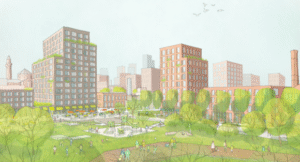Planning, by its very nature, concerns the future. As such, it could be argued that those afforded the greatest influence in planning should be those with the greatest stake in the future – the young.
When the government announced ambitious long-term plans for London, Cambridge, Leeds and other urban areas last July (and made further funding commitments in the Spring Budget), it was immediately apparent that that plans for growth must include a younger representation.
With the average age of a first time buyer being 34, most buying their first home on these new settlements and urban extensions will be at primary school today. Some are not yet born; others may be old enough to contribute to the vision for their city – but do they feel empowered to do so?
There is undoubtedly a need for younger voices in planning discussions, especially considering that new homes tend to attract a younger demographic, and yet the planning applications for that much-needed housing are frequently defeated by planning committees – committees more often than not comprising an older, home-owning demographic, potentially with a vested interest in resisting house building as a result, maintaining high house prices.
The problem is that the planning system simply isn’t set up to engage with those who are not yet on the housing ladder – which tends to be the younger demographic. For many under 35, the prospect of home ownership seems so distant that they are unlikely to engage with the planning process or shape future proposals for residential development. .
This is partly because young people, especially those who are renting, tend to be more mobile. They will not necessarily buy in the area in which they are currently renting, which further reduces the likelihood that they will take part in discussion on development proposals. Figures from the RTPI state that the majority of those who engage in planning are aged over 55; that response rates to a typical pre-planning consultation are around 3% of those directly made aware of it, and for Local Plan consultations, the number is even lower, at less than 1% of the population.
There are many practical reasons for this lack of engagement among the young. For example, planning committees tend to be held during the day when most are at work or caring for children; information about planning applications and consultations is often confined to notification letters sent to existing neighbouring residents and notices in local newspapers – not the headlines which might possibly appear on social media but instead, the small ads which are located towards the end of the print editions – and readership of all newspapers in the UK dropped by two thirds between 2005 and 2021, according to Statistica.
There is so much progress to be made. Councils’ requirements of consultation should go beyond newspaper advertisements, posters on lampposts and communication with parish councils, for example. Technology offers an alternative and an opportunity for a broader reach, but even so, the average Facebook user is now in their 30s. TikTok and other social media platforms may be the means by which many young people engage online, but has such social media ever been used successfully to publicise a planning consultation?
A further issue is that the planning system is skewed towards existing homeowners who are more likely to object to an emerging development proposal or local plan, as they are often directly affected due to their proximity. Neighbour notification letters sent to existing properties close to a
development proposal, a small notice in a local newspaper, or consultation with a parish council are unlikely to reach beyond existing local residents and garner any support. Those most in need of new housing are unlikely to be the recipient of a neighbour notification letter, so how can they be expected to be aware and offer support for a development?
It is a factor of all feedback mechanisms – from restaurant reviews to planning consultations – that those more likely to make an effort to respond are those with a strong objection, rather than those accepting of or indifferent to proposals. Furthermore, a planning system disinclined to elicit responses naturally exacerbates this situation and skews perceptions. Letters of support to local planning authorities, either in relation to development proposals or emerging Local Plans, are few and far between and are typically significantly outweighed by the volume of objections.
The ability of the planning system to reach younger people has traditionally lagged behind that of other sectors despite the fact that young are those most affected by the changes. Perhaps these is an opportunity for the planning and development sector to learn from other sectors, and the large scale city visions present the ideal opportunity to put this into practice.
Image: Elevate
Places for London urging young people to work in the built environment
‘Pioneering’ town project launched to target alarming unemployment rates in young people

















Leave a Reply